Lincoln Head Cents Collection
Lincoln Head Cents Key Dates
In every U.S. coin series, there are certain issues or varieties that because of rarity or limited mintage are the "keys" to assembling a complete date and mint mark collection. Key-Date issues of the Lincoln cent series include the 1909-S V.D.B., the 1909-S, the 1914-D and the 1931-S. Semi-Key Dates, in great demand but not among the scarcest issues, include the "S" mint mark Lincolns of 1910-1915 as well as the 1924-D and 1926-S cents. The Lincoln series also features some prominent varieties which are described after the Key-Date issues:
1909-S V.D.B.
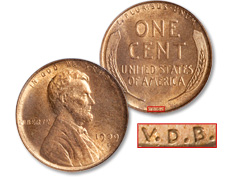
Shortly after the Lincoln cent debuted in 1909, an uproar began over the prominence of the designer Victor David Brenner's initials on the reverse. (Read about the V.D.B. controversy). When the initials were removed after brief production, the 1909-S V.D.B. cent with a small mintage of only 484,000 became the ultimate Key-Date issue of the Lincoln series.
1909-S
During the early years of the Lincoln series, production of cents at the San Francisco Mint was limited. After the designer's V.D.B. initials were removed from the coins partway through 1909, the remaining mintage of cents at San Francisco during that year totaled only 1,825,000. The Key-Date 1909-S Lincoln cent has the fourth lowest mintage of the series.
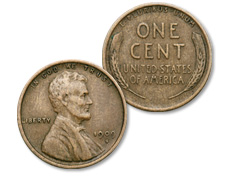
1914-D
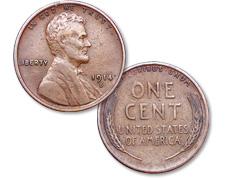
The third lowest mintage Lincoln cent is the 1914-D, with only 1,193,000 cents struck at the Denver Mint in that year (nearly 15 million cents were produced at Denver in 1913 and over 22 million in 1915). The highly prized 1914-D Lincoln cent from the sixth year of the series is described in the official Red Book guide to Lincoln cents as "a rarity in all grades".
1931-S
In the Depression years of the early 1930s, there was little demand for coinage. Only 866,000 cents were produced at the San Francisco Mint in 1931, creating the second-lowest mintage of the Lincoln series. The 1931-S cents were not widely released during their year of issue, and when they later became available, they were recognized as a rarity by collectors and dealers.
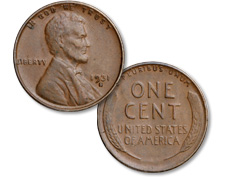
Prominent Varieties
1922 Plain
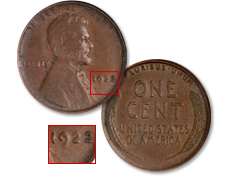
In 1922, with the mint under orders to strike as many silver dollars as possible, no nickels, dimes, quarters or half dollars were produced and cents were struck only at Denver. Because several worn dies were used, many 1922-D cents have a weak "D" mint mark, and some have no visible "D" mint mark. These "1922 Plain" cents have become sought-after rarities.
1943 Steel
Due to a shortage of copper for armaments during the critical war year of 1943, Lincoln cents were minted in zinc-coated steel throughout that year. Struck at the Philadelphia, Denver and San Francisco Mints, 1943 steel cents are now prized mementos of WWII – as are Lincoln cents of 1944-1946, which were struck from spent recycled cartridge cases.
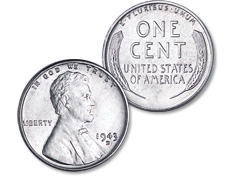
1943 Bronze
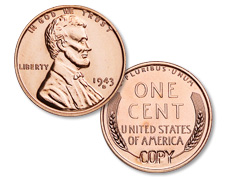
Though all 1943 Lincoln cents were supposed to be struck in zinc-coated steel, a small number of 1943 cents were apparently struck on bronze planchets (coin blanks) left over from previous years. Collectors should be wary, as bronze 1943 cents have been widely simulated by copper-plating 1943 steel cents, or by altering the "8" of 1948 bronze cents. (The one shown here is a replica.)
1955/55 Doubled Die
The famous "1955/55" Doubled Die Lincoln cent exhibits dramatically misaligned images of the date and lettering. The doubled image was struck onto the coins by an improperly produced working die. Like the 1922 Plain, the 1955/55 Doubled Die has become a prized rarity of the Lincoln series. Other less-prominent doubling occurred on other Lincoln issues.
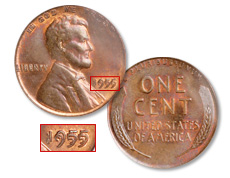
1960 Small Date
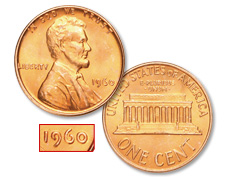
The first Lincoln cents struck at the Philadelphia Mint in 1960 featured small digits in the date. The mint became concerned that the small interior of the "0" might break off the dies – cylindrical steel shafts with recessed images that impress raised images on the coin blanks. The digits were enlarged, and the early 1960 small-date issues became a hard-to-find variety.

